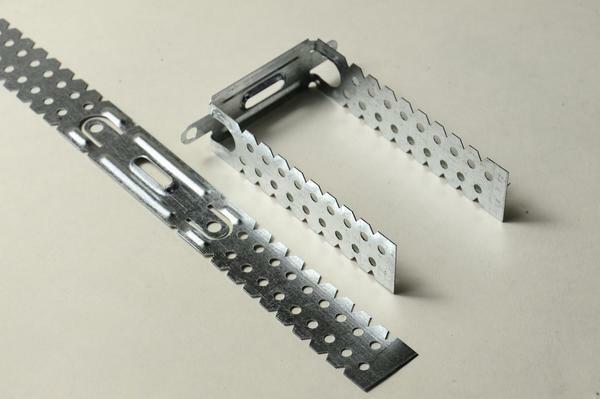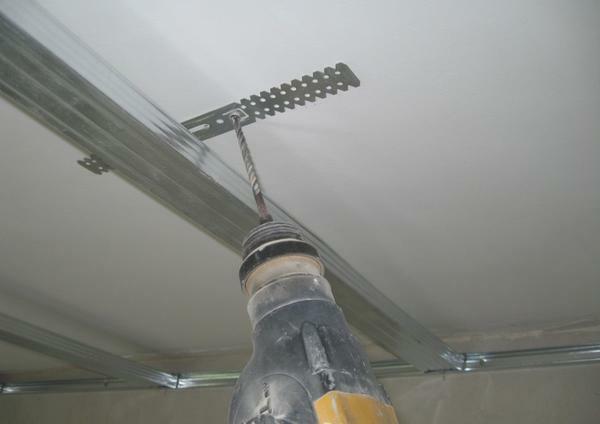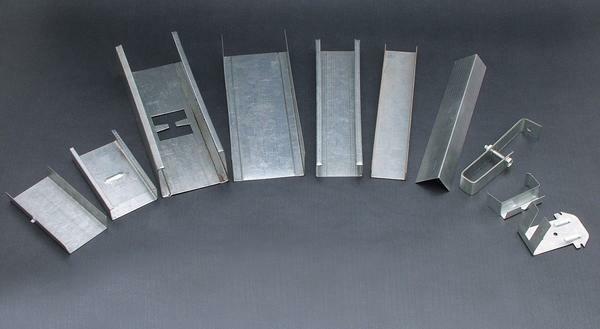 The metal profile is intended for the construction of a structure on which plasterboards or other material is attached. Gypsum board has recently become very popular, because it is a fine, easy-to-install material, setting it on the frame to hide all the shortcomings and unevenness of the walls. Often, sheets of gypsum board are mounted on a frame of metal profiles. If you decide to assemble this structure yourself, then after a while it does not fall apart and is not deformed, you will need to thoroughly study the types and properties of metal profiles.
The metal profile is intended for the construction of a structure on which plasterboards or other material is attached. Gypsum board has recently become very popular, because it is a fine, easy-to-install material, setting it on the frame to hide all the shortcomings and unevenness of the walls. Often, sheets of gypsum board are mounted on a frame of metal profiles. If you decide to assemble this structure yourself, then after a while it does not fall apart and is not deformed, you will need to thoroughly study the types and properties of metal profiles.
-
- Metal profile for drywall: dimensions and types
- Additional elements under the metal profile plasterboard
- The fastened metal profile plasterboard
- Metal profiles for plasterboard: Selection criteria
- Varieties metal profile plasterboard(Video)
Metal profile for gypsum board: dimensions and types
Metal profiles are not corroded, as for andХ Manufacture use the zinced cold-rolled metal, thanks to it the period of their service is long enough. To assemble the right frame for gypsum board, you need to figure out which metal profiles are suitable for these purposes.
 There is a wide variety of types and sizes of metal profiles, so you can choose a model for any
There is a wide variety of types and sizes of metal profiles, so you can choose a model for any
designs. Let's see what kinds of metal profiles exist.
- Rack or vertical profiles, called manufacturers( LED or PP), are one of the main elements of the metal skeleton for installing drywall on walls and ceiling. Thanks to their optimal for all walls, the size, after using such profiles, the minimum number of unnecessary segments remains. Their length is from 2.5 to 4 m, width 60 mm, and height of the shelves is 28 mm.
- Profile guides( MD or PN) have a width of 27 mm, a length of 3 m, a shelf height of 28 mm. They are used for horizontal installation between rack profiles. For the convenience of mounting the frame, such profiles must have a perforation along the entire perimeter.
- The guide retaining profiles are used for the installation of partitions and have the following dimensions: length 2-4 meters, width 4.2 - 15 cm and shelf height 37-40 mm. As you can see, the size range of the profiles( HC) is quite wide, as for the repair, you may need partitions of different sizes.
- Vertical racking profiles for creating partitions have a width of 60 mm, a length of 3-4 m and a shelf height of 40-50 mm. Some of them have special holes for more convenient installation of communications and an additional rib of rigidity.
Arched profiles( PA) are used to make a framework for arches or other curved structures. PAs are both concave and curved. The size range of such profiles is very extensive.
In the absence of arched profiles, having a sufficient level of skill, you can put the desired shape of the rack profiles.
collecting frame structure for plasterboard, keep in mind that each type of profile must be in place, otherwise the fruit of your work will not have a decent appearance.
Additional elements under the metal profile for drywall
Some are metal sections for the construction of the frame under the plasterboard, is not enough, you need to have a more diverse set of fixtures. At the moment there are a huge number of types of additional elements for metal profiles. We will consider those that are considered necessary for working with framework structures.
 include additional elements to be noted metal profile plate, which is intended for mounting to the base structure
include additional elements to be noted metal profile plate, which is intended for mounting to the base structure
Types of additional elements:
- The connector for vertical profiles has two levels. It is sold in an open form, so when using it, it is necessary to bend the two sides at a right angle, along the lines indicated. Two-level connectors are attached using two screws.
- Single-level connectors, better known in construction circles called "crabs", are used to fasten at the intersection of guides. Such fasteners, it is not necessary to install with self-tapping screws, they have special latches, which will fully withstand the load of up to 20 kg.
- Direct suspension is used to install a vertical profile on the ceiling. It is attached directly to the base, pre-bent by the letter P, with the help of self-tapping screws. Its length can be from 7.5 to 30 cm. If you did not find a direct suspension, it can be made independently from a vertical suspension.
- Anchor suspension is used to increase the length of the direct suspension. It is inserted into the metal rack-mount profile, and its thrust is passed through the holes of the spring. Suspension with traction withstands loads up to 25 kg.
- A longitudinal connector is used when the rack profile is not long enough. Such an extension cord is inserted into the PP and fixed on it by two screws.
- The corner connector for the rack profile is used to replace a single-level connector.
Such additional elements must be of high quality and sufficiently strong, because without their help you will not be able to assemble a framework of metal profiles for plasterboard structures.
Than to fix a metal profile from a drywall
In order to assemble all the elements, you will need screws and dowels. To make the structure more durable and durable, it is necessary to understand well the types and sizes of these small but very important parts of the frame.

is used for fastening metal profiles
For self-piercing gypsum boards use self-tapping screws 25 mm long, if you fasten a structure of 2 or more layers of drywall,40 mm. Remember that the correct choice of nails and screws depends directly on the reliability of the plasterboard ceilings and walls you erected. When selecting metal profiles for installation of gypsum boards, pay special attention to their quality, because in construction markets fakes are often unsuitable for work. If you do not recognize the marriage in time, you risk after completing the repair, get uneven and unstable walls and ceiling. Common types of defects: Now you know about the disadvantages of profiles that are most common in construction markets. Carefully choose materials, and your repair will please you for many years. Metal profiles for gypsum board: selection criteria
 The metal profile should be selected based on the dimensions and weight of the material that will be attached to it
The metal profile should be selected based on the dimensions and weight of the material that will be attached to it
Varieties of metal profile for drywall( video)


